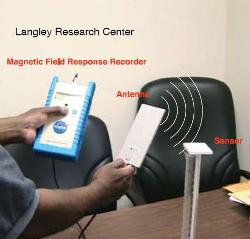May 6 2010
A wireless sensor technology developed by NASA provides recreational boat owners a more accurate and safer method of measuring the boat’s fuel balance. This magnetic measurement system can also be utilized in automobiles, trains and planes.
 NASA Magnetic Field Response Recorder
NASA Magnetic Field Response Recorder
Hampton, VA-based NASA’s Langley Research Center’s Senior Scientist Stan Woodard and Langley ATK Space Division’s electronics technician Bryant Taylor developed the system for wireless measurement of fluid level that removes the requirement of any electrical circuit or component to contact fuel vapors or combustible fuel. This user-friendly system can be easily installed and is being utilized by recreational and commercial boaters already.
Initially this technology was developed for retrofitting safety equipment in ageing aircrafts by NASA. The technology has emerged as a spin off to design and utilize sensors without the drawbacks of many prevalent liquid storage measurement systems.
Readings provided by customary fuel-gauge float systems for marine applications are inaccurate due to the movement of boats. The roll and pitch experienced by a vessel in open waters generates a see-saw effect in fuel gauges. This new wireless-enabled system incorporates two stationary components of conducting material in the fuel and connects to an inductor positioned on the tank’s exterior.
A specialized safety functionality of the system facilitates the total enclosing of the sensors, enabling measurement of the fuel without having to contact electrical components, thereby removing the possibility of fires due to the ignition of combustible vapors of fuel caused by arcing from electrical panels or wires that are damaged or exposed. The system can also be utilized with fuels like acids or various harsh chemicals.
A crucial aspect of this system is that the design is modifiable for the detection of water, a major problem faced by recreational boaters. The system is also modifiable for the detection of the presence of various non-liquid contaminants in the boats tank and is also easily modifiable for other uses though it is primarily for marine applications.
According to Woodard, this basic technology can help design countless types of sensors for a broad range of measurements. He added that this technology will also be available for cars and homes.